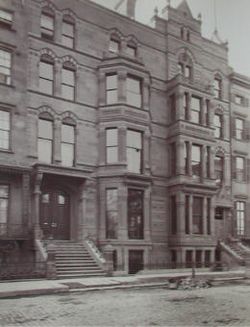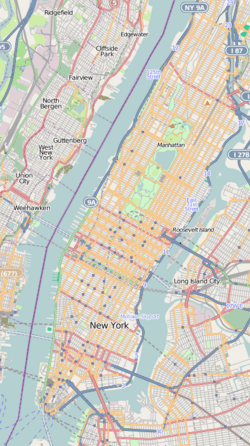Samuel J. Tilden House facts for kids
|
Samuel J. Tilden House
|
|

(1872, before being combined and redone by Vaux)
|
|
| Location | 15 Gramercy Park South, Manhattan, New York City, New York |
|---|---|
| Built | c. 1840s; altered extensively 1884 |
| Architect | Calvert Vaux |
| Architectural style | Gothic Revival |
| NRHP reference No. | 76001251 |
Quick facts for kids Significant dates |
|
| Added to NRHP | May 11, 1976 |
| Designated NHL | May 11, 1976 |
The Samuel J. Tilden House is a famous historic building in Manhattan, New York City. It's actually two townhouses combined into one. Built around 1845, it was the home of Samuel J. Tilden from 1860 until he passed away in 1886.
Samuel J. Tilden was an important person in American history. He was a former governor of New York State. He was also a strong opponent of political corruption, especially groups like the Tweed Ring and Tammany Hall. He even ran for president in the 1876 election.
Between 1881 and 1884, a famous architect named Calvert Vaux redesigned and combined the two houses. The result is a beautiful building known for its Victorian Gothic style with some Italian Renaissance touches. Since 1906, the building has been the home of the National Arts Club, a private club for people interested in the arts.
About the Tilden House
The Samuel J. Tilden House stands on the south side of Gramercy Park. It faces the park, which is a private green space in New York City. The building is four stories tall and made mostly of pink sandstone. It has a smooth, finished look.
Design and Features
The house's outside has special details. Pink marble is used around the entrances. Shiny stone pieces are also found along some of the horizontal lines of the building. Inside, many of the original Victorian features from Calvert Vaux's redesign are still there. These include beautiful parquet floors and wood panels that go from the floor to the ceiling. The National Arts Club has also kept other carved details, which you can see in the basement areas.
How the House Changed Over Time
The two original rowhouses were built in the 1840s. This was after Gramercy Park was first designed by Samuel B. Ruggles. Samuel J. Tilden first bought Number 15, and later Number 14, in the 1860s. He lived in the combined houses until he died.
During these years, Tilden became very well-known. He successfully fought against powerful political groups, sometimes called "political machines," like Tammany Hall. These groups tried to control city politics. Because of his efforts, he became the Governor of New York in 1875.
He ran for president in 1876. He won the most votes from the public. However, he lost the election in the electoral college to Rutherford B. Hayes. This election was very controversial. It is often seen as the end of the Reconstruction period after the American Civil War. During these busy and sometimes difficult times, Tilden even had rolling steel doors and a secret escape tunnel in his house!
The house was greatly updated in the 1880s by Calvert Vaux. He changed its style from Greek Revival to a more Italian-inspired Victorian look. Since 1906, the National Arts Club has used the house as its headquarters. The building was named a New York City landmark in 1966. It was then declared a National Historic Landmark in 1976. This means it's a very important historical site in the United States. It is the only known home connected to Samuel J. Tilden's life. The house is also part of the larger Gramercy Park Historic District.
See also
 In Spanish: Casa Samuel J. Tilden para niños
In Spanish: Casa Samuel J. Tilden para niños




